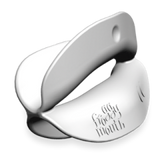
What if we breathed through the nose?
Explore the impact of nasal breathing on growth and health in our article. Learn how tongue posture and the nose play a key role in facial development and prevent sleep disorders in children.
DO YOU REALLY KNOW THE CONSEQUENCES OF MOUTH BREATHING, ON OUR GROWTH, OUR POSTURE, THE QUALITY OF OUR SLEEP, OUR ORAL HEALTH, ULTIMATELY, OUR GENERAL HEALTH?
BREATHING & FACIAL GROWTH
Harvold's experiment, published in 1981 in the American Journal of Orthodontics, demonstrated the anatomical influence of exclusive mouth breathing.
The technique found in the 1980s to demonstrate the impact of breathing on facial growth may not be used today, but it allowed an undeniable demonstration.
It consisted of artificially obstructing the nostrils of young monkeys in full growth and comparing the different levels of the face with other young monkeys that could breathe through the nose.
The result was clear, and the same characteristics of mouth breathing as in humans were found.

ROLE OF THE NOSE
WE HAVE JUST SEEN THE ANATOMICAL CONSEQUENCES, BUT WHAT IS THE PURPOSE OF THE NOSE, WHAT IS ITS FUNDAMENTAL ROLE IN THE FUNCTIONING OF THE GENERAL BALANCE OF THE BODY?

The air we breathe must pass through our nose to be filtered of unwanted particles in our lungs, and simultaneously its passage near the brain, just behind the nasal cavity, also allows it to cool down.
The monkeys whose airways were blocked had particularly long faces, an open-mouth posture, marked lingual projection, gaps, and narrowness of the jaws.
This is part of the reason why sleep and breathing are so linked, and if sleep is influenced, it is actually the whole psychoemotional development of the growing child that is affected.
But the nose is not the only organ involved in breathing...
"The tongue is a respiratory organ" Pr. Dr. Takashi Ono
This statement by Pr. Takashi ONO, former president of the WFO, had marked minds at the World Sleep Congress in Vancouver in 2019.
BUT WHAT DID HE MEAN BY THAT? WE OFTEN HEAR THAT MAINTAINING ATYPICAL SWALLOWING WILL HINDER THE AUTOMATION OF NASAL BREATHING, HOW IS IT RELATED?

Until the age of three and the establishment of mastication, the tongue plays the role of a suction pump, to swallow (suck-swallow).
Only at this age should it change posture to allow for secondary swallowing (arches in occlusion and tongue against the palate (anterior as well as posterior).

The development of the nasal cavity depends on that of its neighbor below: the palate.
It is the tongue that acts as a shaper of the oral cavity.
Its vertical elevation is necessary for the optimal development of the upper jaw. This notably allows for the stimulation of the palatine suture.
Thus are made the bones of our skull: the container adapts to the content, the cranial box is never smaller than the size of our brain.
In physiological swallowing, the palate is never smaller than the upper part of the tongue.
But if the tongue does not rise against the palatal vault, can interpose between the arches, it will not play its role of shaper of the cavity, then there will be no growth and not enough space to breathe through the nose.
This is understood by a quite simple example: the nasal cavities are the neighbors above the palate.
It is therefore absolutely necessary to allow the elevation of the posterior part of the tongue.
IN THE PREFACE OF THE BOOK "FROM DYSFUNCTION TO DYSMORPHOSIS", BY DR. FELLUS, PUBLISHED IN 2015 BY EDITIONS ORTHOPOLIS, PROFESSOR JEAN DELAIRE HIGHLIGHTED A VERY IMPORTANT POINT OF OUR REEDUCATIONS BY EVOKING THE DUAL FUNCTIONAL NECESSITY: POSTERIOR LINGUAL AND OCCLUSAL.
"This double functional necessity, posterior lingual and occlusal, too often forgotten by the reeducators of the oro-facial functions is probably one of the causes of the too frequent failures of the reeducations". Prof. Jean Delaire, 2015
While good occlusion as a criterion of good lingual posture has never been debated, it is important to dwell on this posterior lingual necessity.
Which tongue posture allows you to breathe through your mouth according to you?
You would all answer "the low posture"!
"Lingual dyspraxia is often correlated with oral ventilation. With incorrect lingual posture, the anterior part of the tongue is carried forward or downward, which will raise the retro-basal-lingual part, thus reducing the respiratory tract.
Placing the lingual apex on the retroincisal papilla causes the base of the tongue to relax and the aerodigestive tract to be freed.
Therefore, we could say that the lingual posture conditions the nasal ventilation, but the opposite is also true. A patient with chronic nasal obstruction has no choice but to use the oral airway." ».
Frédéric Courson, Nicolas Fougeront, Hélène Gil, Philippe Amat, Revue d’Orthopédie Dento-Faciale 2021 - Vol. 55.

The high posture of the tongue prevents breathing through the mouth, but beware, not just any posture. Let's be attentive, a tongue whose only tip rises will not play this role effectively, the tongue must rise entirely and particularly the posterior part to be in contact with the palatal vault. It's the styloglossal play that will allow us to achieve this balance, hence the quote from Prof. Delaire.
P.S. You can do the test yourself:
1) Raise the posterior part of your tongue against the palate.
2) Open your mouth, still with the tongue against the palate.
3) Try to breathe through your mouth.
So? Difficult huh?
BUT HOW TO INFLUENCE THE RESTING POSTURE OF THE TONGUE?
The tongue moves during swallowing and then returns to its resting posture from which it will not move for about fifty seconds, until the next swallowing. It is this resting posture that we therefore want to influence.
Fortunately for us, there are two arguments that the tongue understands very well, comfort and minimum effort.
Our tongue is a bit in perpetual adolescence finally…

That's why we place so much importance on the styloglossus.
It's the styloglossus that will raise the tongue against the palatal vault more than 2000 times a day to swallow our saliva, it will keep a high resting posture.
It is therefore necessary to automate a swallowing praxis with elevation of the posterior part of the tongue to obtain a resting posture that inhibits mouth breathing.
The posterior seal, that is the seal created by the elevation of the styloglossus in the oral cavity, is the key to durably reeducate breathing, and not the achievement of a labial closure by muscular contraction.

FroggyMouth acts in this direction by inhibiting the bad praxis.
We know that automation comes through inhibition and physiological comfort.
1) The elevation of the styloglossus obtained with Froggymouth.
2) The establishment of exclusive nasal breathing thanks to this posterior lingual seal, constituted by the lingual dome against the palate.





